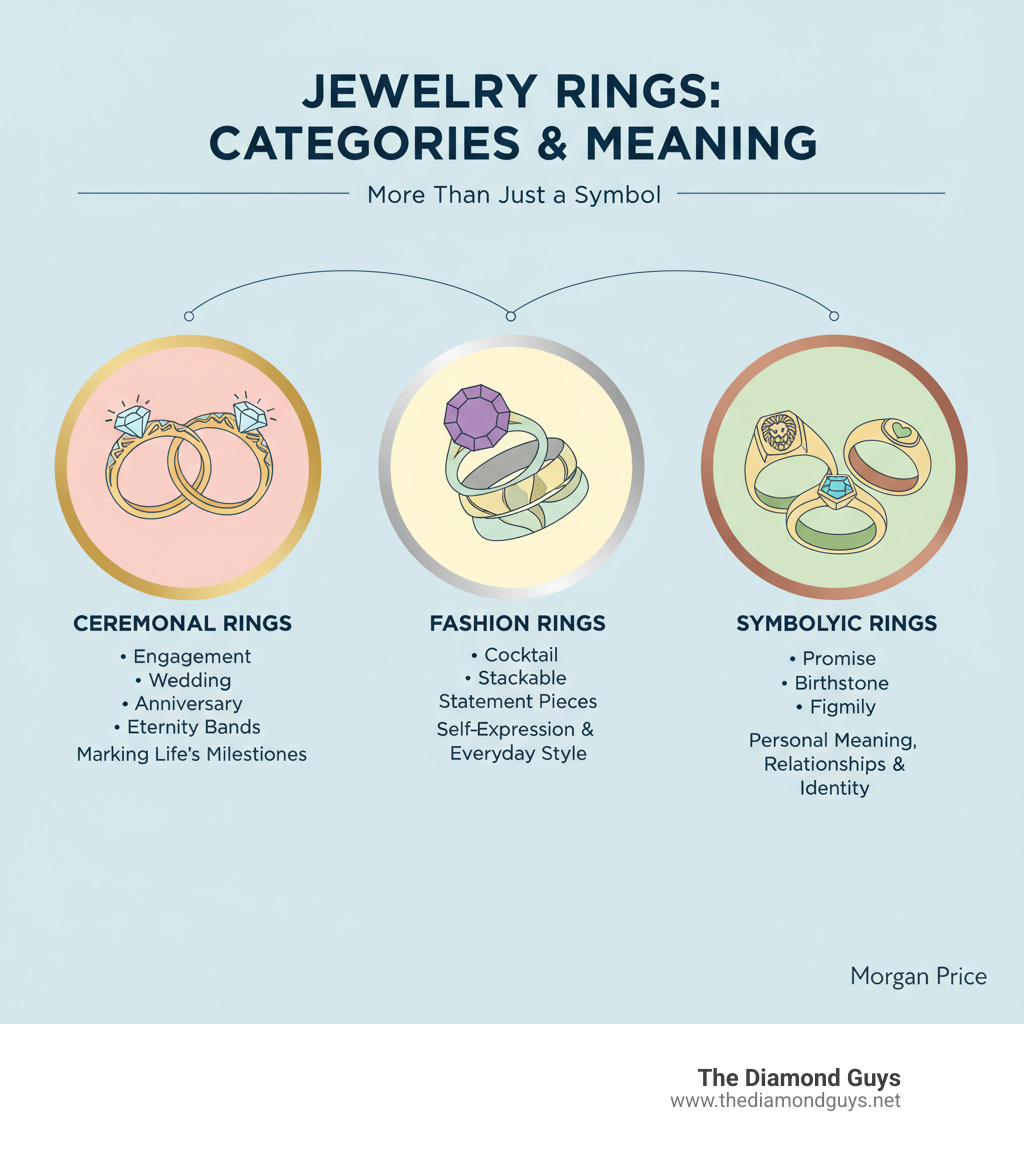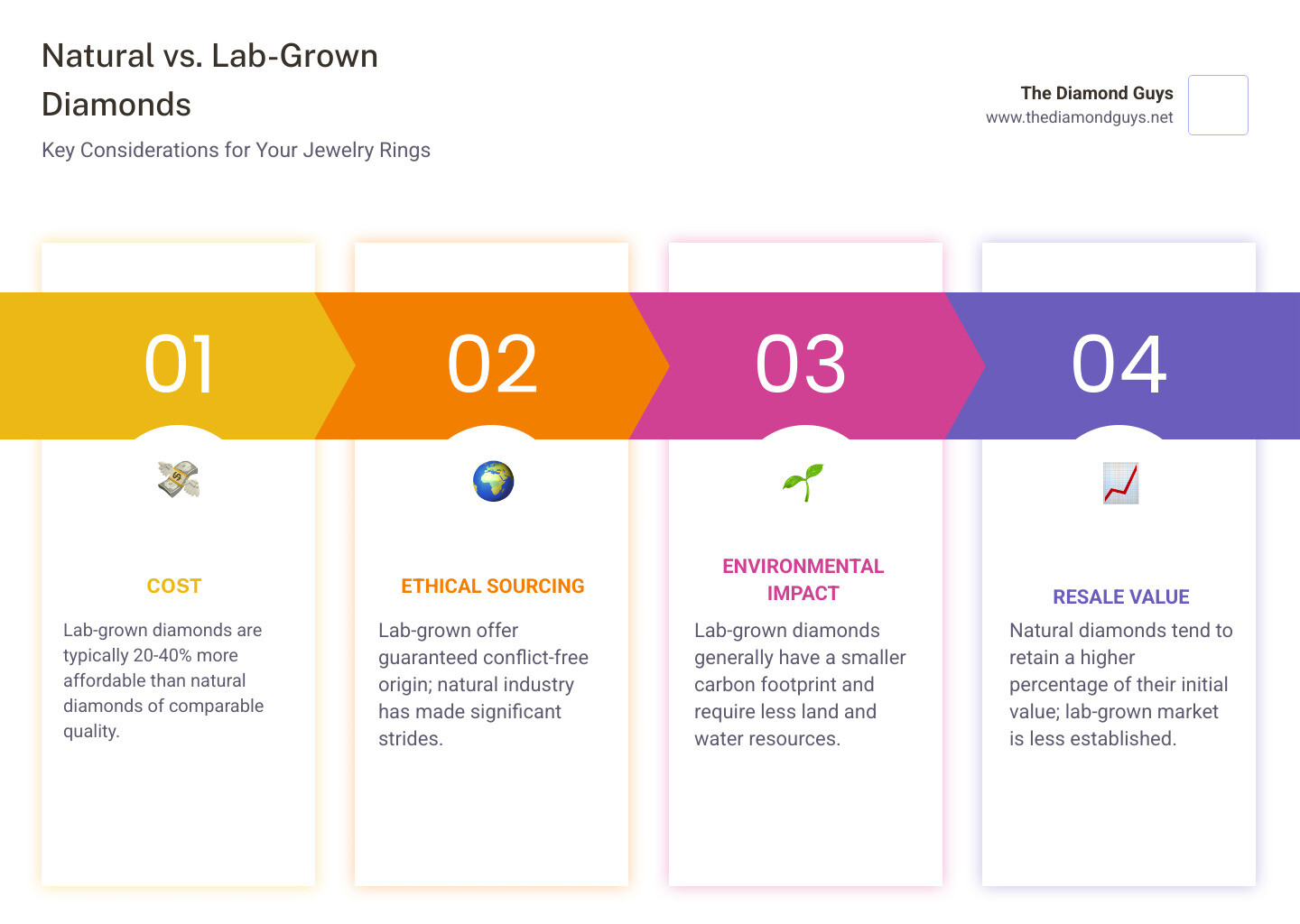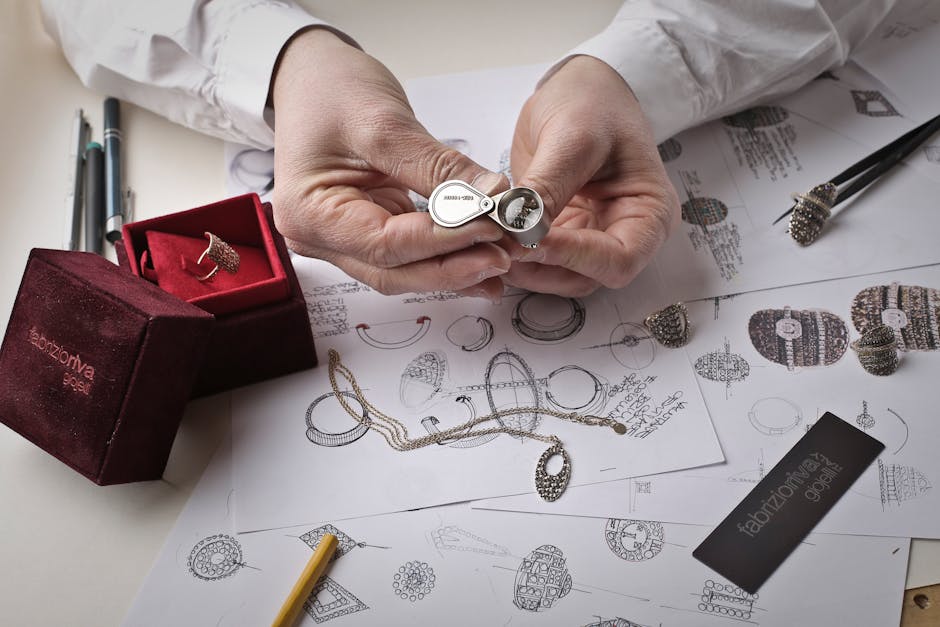More Than Just Engagement: Discovering Diverse Jewelry Rings
Why Jewelry Rings Are More Than Just a Symbol
Jewelry rings are powerful expressions of love, identity, and personal style that go far beyond the engagement moment. From ceremonial wedding bands and fashion-forward cocktail rings to symbolic birthstone pieces, there is a ring for every story.
The growing global rings market, valued at USD 27.5 billion in 2022, reflects this diversity. Today's consumers have more choices than ever, from classic platinum solitaires over $15,000 to sterling silver styles under $500. A major development is the rise of lab-grown diamonds, which now represent 32% of new designs and offer identical beauty at a more accessible price.
I'm Morgan Price, and my work with top jewelry brands and ethical suppliers has given me a front-row seat to the evolution of the jewelry rings market. This guide will help you steer the exciting world of metals, gemstones, and styles to find a piece that truly speaks to you.

Beyond the Proposal: A World of Ring Types
While jewelry rings are famously associated with proposals, they tell a much richer story. Rings mark anniversaries, celebrate personal style, honor family heritage, and add a touch of joy to any day. The world of rings is vast, with each type carrying its own meaning and purpose.
Exploring Different Types of Jewelry Rings
- Engagement rings: The quintessential symbol of commitment, typically featuring a prominent center stone. If you're starting this journey, our guides on How to Start Engagement Ring Shopping and Princess Perfect: A Deep Dive into Engagement Ring Styles are essential reading.
- Wedding bands: Worn by both partners to signify eternal love. They are usually simpler bands that complement an engagement ring. We answer common questions like Do You Wear a Wedding Band Above or Below Your Engagement Ring and offer tips on How to Choose a Men's Wedding Band.
- Promise rings: A symbol of serious commitment before an engagement. Learn more in our article, Is a Promise Ring an Engagement Ring.
- Eternity rings: Bands encircled with gemstones, representing never-ending love. They are often given for major anniversaries or the birth of a child.
- Anniversary bands: Mark marital milestones with designs that commemorate years shared together.
- Fashion & Cocktail rings: All about self-expression. Fashion rings are for everyday style, while large, glamorous cocktail rings are showstoppers for special occasions.
- Signet rings: Historically used to seal documents, these rings are now engraved with personal initials or symbols for a touch of timeless sophistication.
- Birthstone rings: Featuring the gemstone associated with your birth month, making for a wonderfully personal and symbolic gift.
- Stackable rings: Slender bands designed to be layered, allowing for endless creative combinations. Find out more in What is a Stackable Ring.
Designs like the split-shank ring, where the band divides as it nears the center stone, add further visual interest and uniqueness.
Ceremonial vs. Everyday Wear
When choosing jewelry rings, consider how you'll wear them. Ceremonial rings, like engagement and wedding bands, are built for a lifetime of wear. They are crafted from durable metals like platinum or 14K/18K gold and feature hard gemstones like diamonds, with timeless designs that endure.
Everyday wear rings, such as fashion and stackable pieces, offer more creative freedom. While durability is still important, materials like sterling silver and more delicate designs become viable options. These rings allow you to experiment with trends, add pops of color, and express your mood. The key is to choose rings that fit your lifestyle, ensuring they are worn and enjoyed rather than left in a jewelry box.
The Anatomy of a Ring: Popular Metals and Gemstones
The metal and gemstones you choose are the vocabulary of your ring's story, defining its appearance, durability, and character.
A Guide to Precious Metals
The ring's metal is its foundation. Each type offers a distinct look and feel.

- Gold: The classic choice, available in three main colors. Yellow gold is warm and traditional. White gold offers a modern, silvery finish (it requires periodic rhodium re-plating to maintain its brightness). Rose gold has a romantic, pinkish hue from a higher copper content.
- Karats: Gold purity is measured in karats. 24K is pure but too soft for rings. 14K gold (58.3% pure) offers excellent durability, while 18K gold (75% pure) has a richer color.
- Platinum: A naturally white, dense, and highly durable metal. It's hypoallergenic and an excellent choice for securing gemstones for a lifetime of wear, making it a favorite for wedding bands. Learn more in What Are Men's Wedding Bands Made Of.
- Sterling Silver: An affordable and beautiful option with a bright white luster. It's 92.5% pure silver but can tarnish and requires regular cleaning, making it ideal for fashion jewelry.
The Symbolism of Gemstones
Gemstones give jewelry rings their soul, each carrying its own meaning and beauty.
- Diamonds: Symbolizing eternal love and strength, their best hardness makes them perfect for everyday wear. Understanding the 4Cs—carat, color, clarity, and cut—is key to making an informed choice.
- Sapphires, Rubies, and Emeralds: These "big three" colored gemstones are popular alternatives. Blue sapphires represent loyalty, red rubies symbolize passion, and green emeralds signify hope and rebirth. The popularity of gemstones for engagement rings is on the rise.
- Birthstones: Each month's associated stone adds a deeply personal layer of meaning to a ring.
- Diamond Alternatives: For those seeking other options, moissanite and cubic zirconia offer brilliant sparkle at different price points. It's important to understand their unique properties, such as the difference between moissanite and a lab-grown diamond.
Whether you're drawn to a classic diamond or a unique colored stone like a yellow diamond, the gemstone you choose makes your ring's story personal.
Design, Style, and Personalization
This section explores the artistry of ring design, from timeless styles to making a piece uniquely yours.
Classic vs. Contemporary Designs
Jewelry rings bridge history and innovation. Classic designs often feature vintage-inspired details like milgrain (tiny metal beads) and filigree (delicate lace-like metalwork). Historical eras like Art Deco (1915-1930s), with its bold geometry and fancy-cut diamonds, continue to influence modern styles. Our guide to Engagement Ring Styles explores these timeless looks.
Contemporary designs favor modern minimalism with clean lines and sleek silhouettes. Iconic motifs—such as sculptural knot accents, interlocking bands, and architectural forms—have become timeless symbols of love and connection, blending classic and modern sensibilities. Today's engagement ring trends often mix these elements for a personalized feel.

The Art of Stacking and Styling
Styling jewelry rings is a creative way to tell your personal story. Don't be afraid to mix metals like yellow, white, and rose gold for a dynamic look. Combining different textures—such as polished, hammered, or pavé-set bands—adds depth and visual interest.
Stackable rings are designed for this purpose, allowing you to build a collection over time that represents different life chapters. For a balanced look, pair a bold statement ring with more delicate bands. The key is to experiment and create a combination that feels authentic to you. Learn more with our tips on How to Wear Multiple Diamond Rings.
Personalizing Your Jewelry Rings for a Unique Touch
Personalization transforms a beautiful ring into an irreplaceable keepsake.
- Engraving: Add initials, a special date, or a short message for an intimate detail that makes the ring uniquely yours.
- Custom Design: Create a ring from scratch by selecting every element, from the metal to the gemstone and setting. We make it easy with our guide on The Three Easy Steps to Customizing Your Dream Ring.
- Meaningful Gemstones: Incorporate birthstones or stones with specific symbolic meaning to add another layer of significance. Custom two-stone designs are a beautiful way to symbolize a partnership or the bond between two people.
The Rise of Lab-Grown Diamonds in the Ring Market
The jewelry world has been transformed by lab-grown diamonds. These are not imitations; they are real diamonds with a different origin story, offering the same sparkle and durability as their mined counterparts.
Understanding Lab-Grown Diamonds
So, are lab-grown diamonds real diamonds? The answer is an emphatic yes. Created in labs that replicate the Earth's natural diamond-forming process, they are optically, chemically, and physically identical to natural diamonds. The two main creation methods are High-Pressure/High-Temperature (HPHT) and Chemical Vapor Deposition (CVD).
This technology has become a mainstream choice, and because they are real diamonds, they pass a diamond tester and are just as strong as natural diamonds. Myths about them getting cloudy are false. They are a modern, beautiful choice for any jewelry, including stunning green lab-grown diamonds.
Natural vs. Lab-Grown: Making an Informed Choice
Choosing between a natural and lab-grown diamond is a personal decision based on your priorities.

- Cost: Lab-grown diamonds typically cost 20-40% less than natural diamonds of the same size and quality, allowing you to get a larger stone or a more intricate setting for your budget.
- Ethical Sourcing: Lab-grown diamonds offer a fully traceable, conflict-free origin, eliminating any sourcing concerns.
- Environmental Impact: The creation process generally involves less land disturbance and can have a smaller carbon footprint than mining.
- Resale Value: Currently, natural diamonds tend to retain a higher percentage of their value over time. The resale market for lab-grown diamonds is still developing, which is an important consideration if future value is a priority.
The "right" diamond is the one that aligns with your values and budget. We explore this topic further in our articles on Lab Diamonds vs Real Diamonds and whether you should buy a lab-grown diamond engagement ring.
A Buyer's Guide to Choosing the Perfect Jewelry Rings
This section provides a practical checklist to help you make a confident and informed purchase.
Key Factors to Consider
Choosing the perfect jewelry rings is an exciting process. Keep these factors in mind to guide your search.

- Budget: Establish a comfortable price range early on. Rings are available at all price points, from affordable sterling silver pieces to exquisite platinum and diamond creations. If you're shopping for an engagement ring, our guide on how to afford your dream ring can help.
- Personal Style: Consider your aesthetic. Do you prefer classic, modern, vintage-inspired, or bold designs? Your existing jewelry collection can offer clues. Our guide on how to start engagement ring shopping emphasizes understanding style preferences.
- Lifestyle: An active lifestyle calls for durable metals like platinum or 14K gold and lower-profile settings that won't snag. For special occasion rings, you can opt for more delicate and intricate designs.
- Metal and Gemstone: Choose materials that fit your durability needs, maintenance preferences, and aesthetic. Consider skin tone, color preference, and the symbolism of the gemstone.
- Ring Setting: The setting secures the gemstone and defines the ring's overall style. Popular options include solitaire, halo, pavé, and bezel settings, each offering a unique look and level of protection. Learn more in our guide on how to choose a diamond ring setting.
Getting the Size and Fit Right
A well-fitting ring is crucial for comfort and security. A ring that's too loose can be lost, while one that's too tight is uncomfortable.
- Measurement: The most accurate way to determine your size is to be professionally measured by a jeweler. At-home tools can provide a good estimate, but be aware that finger size can fluctuate with temperature and time of day.
- Fit and Width: A wider band will feel tighter than a thinner band of the same size, so you may need to size up for wider rings. A proper fit means the ring slides over the knuckle with slight resistance and sits comfortably at the base of your finger.
- Resizing: Most gold and platinum rings can be resized by a skilled jeweler. However, rings like eternity bands or those with continuous patterns are difficult or impossible to resize. It's always best to get the size right from the start. We cover this in our guide, Can Engagement Rings Be Resized.
Frequently Asked Questions about Jewelry Rings
Here are answers to some of the most common questions we receive from clients about their jewelry rings.
How do I care for my rings?
Proper care will keep your rings sparkling for years to come.
- Cleaning: Clean gold and platinum rings with warm water, mild dish soap, and a soft brush. Use a dedicated polishing cloth for sterling silver to prevent tarnish.
- Storage: Store rings separately in a fabric-lined box or soft pouches to prevent scratching.
- When to Remove: Take rings off before cleaning, gardening, heavy lifting, swimming, or applying lotions and perfumes to avoid damage and buildup.
- Professional Maintenance: Have your rings professionally cleaned and inspected at least once a year to check for loose stones or worn prongs. This is crucial, as even a diamond can chip or break with a hard impact.
What are the latest trends in designer rings?
The world of jewelry rings is always evolving. Current trends include:
- Mixed-metal designs: Combining yellow, white, and rose gold for a versatile and modern look.
- Lab-grown colored gemstones: Offering vibrant hues for unique, personalized pieces.
- Bold, chunky styles: Statement rings with substantial bands and oversized gems are making a comeback.
- Personalization: A growing demand for custom pieces with engravings or meaningful gemstone combinations that tell a personal story.
Can I insure a ring with a lab-grown diamond?
Yes, you can and should insure a ring with a lab-grown diamond. Most jewelry insurers recognize lab-grown diamonds as real diamonds and offer policies identical to those for natural diamonds.
You will need a professional appraisal that details your ring's characteristics and value. This document is the basis for your insurance policy, which provides peace of mind against loss, theft, or damage. For more detailed information, please see our guides on how to insure a lab-grown diamond and jewelry protection in Arizona.
Conclusion
Jewelry rings are far more than just accessories; they are carriers of meaning, markers of milestones, and expressions of who we are. From a classic solitaire engagement ring to a vibrant stack of fashion bands, every ring tells a story worth celebrating.
We've explored the diverse world of rings, the character of different metals and gemstones, and the exciting possibilities of both classic and contemporary design. We've also seen how the lab-grown diamond revolution offers new choices for accessible luxury and ethical sourcing.
What matters most is finding a piece that speaks to you. Quality craftsmanship and ethical sourcing are paramount, but the right ring is the one that resonates with your heart.
At The Diamond Guys, we provide expert guidance and a personalized shopping experience in Scottsdale, AZ, and Los Angeles, CA. We are dedicated to helping you find or create the perfect ring that tells your unique story. Our transparent, caring approach is what sets us apart.
Your perfect ring is waiting. We invite you to explore the possibilities and find what makes your heart skip a beat. For more insights and inspiration, visit The Diamond Guys Blog.




